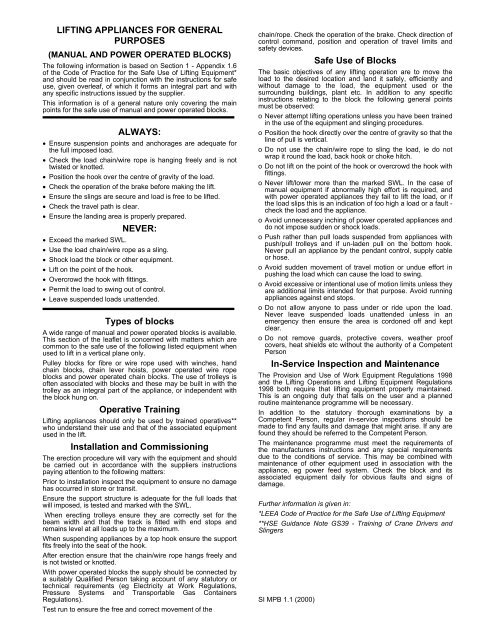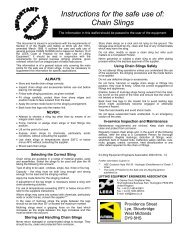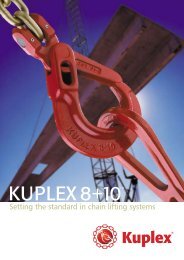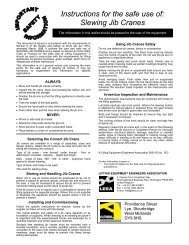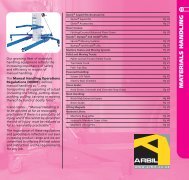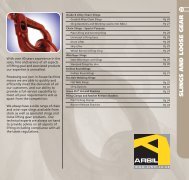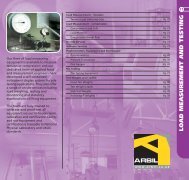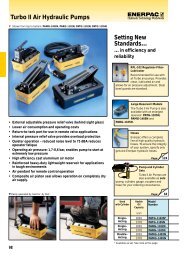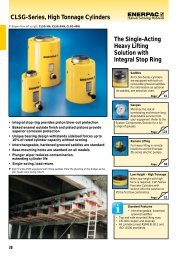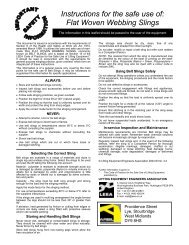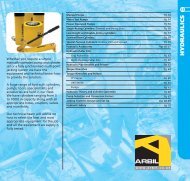Instructions for the safe use of: Hand Chain Blocks - Arbil Lifting Gear
Instructions for the safe use of: Hand Chain Blocks - Arbil Lifting Gear
Instructions for the safe use of: Hand Chain Blocks - Arbil Lifting Gear
You also want an ePaper? Increase the reach of your titles
YUMPU automatically turns print PDFs into web optimized ePapers that Google loves.
LIFTING APPLIANCES FOR GENERALPURPOSES(MANUAL AND POWER OPERATED BLOCKS)The following in<strong>for</strong>mation is based on Section 1 - Appendix 1.6<strong>of</strong> <strong>the</strong> Code <strong>of</strong> Practice <strong>for</strong> <strong>the</strong> Safe Use <strong>of</strong> <strong>Lifting</strong> Equipment*and should be read in conjunction with <strong>the</strong> instructions <strong>for</strong> <strong>safe</strong><strong>use</strong>, given overleaf, <strong>of</strong> which it <strong>for</strong>ms an integral part and withany specific instructions issued by <strong>the</strong> supplier.This in<strong>for</strong>mation is <strong>of</strong> a general nature only covering <strong>the</strong> mainpoints <strong>for</strong> <strong>the</strong> <strong>safe</strong> <strong>use</strong> <strong>of</strong> manual and power operated blocks.ALWAYS:• Ensure suspension points and anchorages are adequate <strong>for</strong><strong>the</strong> full imposed load.• Check <strong>the</strong> load chain/wire rope is hanging freely and is nottwisted or knotted.• Position <strong>the</strong> hook over <strong>the</strong> centre <strong>of</strong> gravity <strong>of</strong> <strong>the</strong> load.• Check <strong>the</strong> operation <strong>of</strong> <strong>the</strong> brake be<strong>for</strong>e making <strong>the</strong> lift.• Ensure <strong>the</strong> slings are secure and load is free to be lifted.• Check <strong>the</strong> travel path is clear.• Ensure <strong>the</strong> landing area is properly prepared.NEVER:• Exceed <strong>the</strong> marked SWL.• Use <strong>the</strong> load chain/wire rope as a sling.• Shock load <strong>the</strong> block or o<strong>the</strong>r equipment.• Lift on <strong>the</strong> point <strong>of</strong> <strong>the</strong> hook.• Overcrowd <strong>the</strong> hook with fittings.• Permit <strong>the</strong> load to swing out <strong>of</strong> control.• Leave suspended loads unattended.Types <strong>of</strong> blocksA wide range <strong>of</strong> manual and power operated blocks is available.This section <strong>of</strong> <strong>the</strong> leaflet is concerned with matters which arecommon to <strong>the</strong> <strong>safe</strong> <strong>use</strong> <strong>of</strong> <strong>the</strong> following listed equipment when<strong>use</strong>d to lift in a vertical plane only.Pulley blocks <strong>for</strong> fibre or wire rope <strong>use</strong>d with winches, handchain blocks, chain lever hoists, power operated wire ropeblocks and power operated chain blocks. The <strong>use</strong> <strong>of</strong> trolleys is<strong>of</strong>ten associated with blocks and <strong>the</strong>se may be built in with <strong>the</strong>trolley as an integral part <strong>of</strong> <strong>the</strong> appliance, or independent with<strong>the</strong> block hung on.Operative Training<strong>Lifting</strong> appliances should only be <strong>use</strong>d by trained operatives**who understand <strong>the</strong>ir <strong>use</strong> and that <strong>of</strong> <strong>the</strong> associated equipment<strong>use</strong>d in <strong>the</strong> lift.Installation and CommissioningThe erection procedure will vary with <strong>the</strong> equipment and shouldbe carried out in accordance with <strong>the</strong> suppliers instructionspaying attention to <strong>the</strong> following matters:Prior to installation inspect <strong>the</strong> equipment to ensure no damagehas occurred in store or transit.Ensure <strong>the</strong> support structure is adequate <strong>for</strong> <strong>the</strong> full loads thatwill imposed, is tested and marked with <strong>the</strong> SWL.When erecting trolleys ensure <strong>the</strong>y are correctly set <strong>for</strong> <strong>the</strong>beam width and that <strong>the</strong> track is fitted with end stops andremains level at all loads up to <strong>the</strong> maximum.When suspending appliances by a top hook ensure <strong>the</strong> supportfits freely into <strong>the</strong> seat <strong>of</strong> <strong>the</strong> hook.After erection ensure that <strong>the</strong> chain/wire rope hangs freely andis not twisted or knotted.With power operated blocks <strong>the</strong> supply should be connected bya suitably Qualified Person taking account <strong>of</strong> any statutory ortechnical requirements (eg Electricity at Work Regulations,Pressure Systems and Transportable Gas ContainersRegulations).Test run to ensure <strong>the</strong> free and correct movement <strong>of</strong> <strong>the</strong>chain/rope. Check <strong>the</strong> operation <strong>of</strong> <strong>the</strong> brake. Check direction <strong>of</strong>control command, position and operation <strong>of</strong> travel limits and<strong>safe</strong>ty devices.Safe Use <strong>of</strong> <strong>Blocks</strong>The basic objectives <strong>of</strong> any lifting operation are to move <strong>the</strong>load to <strong>the</strong> desired location and land it <strong>safe</strong>ly, efficiently andwithout damage to <strong>the</strong> load, <strong>the</strong> equipment <strong>use</strong>d or <strong>the</strong>surrounding buildings, plant etc. In addition to any specificinstructions relating to <strong>the</strong> block <strong>the</strong> following general pointsmust be observed:o Never attempt lifting operations unless you have been trainedin <strong>the</strong> <strong>use</strong> <strong>of</strong> <strong>the</strong> equipment and slinging procedures.o Position <strong>the</strong> hook directly over <strong>the</strong> centre <strong>of</strong> gravity so that <strong>the</strong>line <strong>of</strong> pull is vertical.o Do not <strong>use</strong> <strong>the</strong> chain/wire rope to sling <strong>the</strong> load, ie do notwrap it round <strong>the</strong> load, back hook or choke hitch.o Do not lift on <strong>the</strong> point <strong>of</strong> <strong>the</strong> hook or overcrowd <strong>the</strong> hook withfittings.o Never lift/lower more than <strong>the</strong> marked SWL. In <strong>the</strong> case <strong>of</strong>manual equipment if abnormally high ef<strong>for</strong>t is required, andwith power operated appliances <strong>the</strong>y fail to lift <strong>the</strong> load, or if<strong>the</strong> load slips this is an indication <strong>of</strong> too high a load or a fault -check <strong>the</strong> load and <strong>the</strong> appliance.o Avoid unnecessary inching <strong>of</strong> power operated appliances anddo not impose sudden or shock loads.o Push ra<strong>the</strong>r than pull loads suspended from appliances withpush/pull trolleys and if un-laden pull on <strong>the</strong> bottom hook.Never pull an appliance by <strong>the</strong> pendant control, supply cableor hose.o Avoid sudden movement <strong>of</strong> travel motion or undue ef<strong>for</strong>t inpushing <strong>the</strong> load which can ca<strong>use</strong> <strong>the</strong> load to swing.o Avoid excessive or intentional <strong>use</strong> <strong>of</strong> motion limits unless <strong>the</strong>yare additional limits intended <strong>for</strong> that purpose. Avoid runningappliances against end stops.o Do not allow anyone to pass under or ride upon <strong>the</strong> load.Never leave suspended loads unattended unless in anemergency <strong>the</strong>n ensure <strong>the</strong> area is cordoned <strong>of</strong>f and keptclear.o Do not remove guards, protective covers, wea<strong>the</strong>r pro<strong>of</strong>covers, heat shields etc without <strong>the</strong> authority <strong>of</strong> a CompetentPersonIn-Service Inspection and MaintenanceThe Provision and Use <strong>of</strong> Work Equipment Regulations 1998and <strong>the</strong> <strong>Lifting</strong> Operations and <strong>Lifting</strong> Equipment Regulations1998 both require that lifting equipment properly maintained.This is an ongoing duty that falls on <strong>the</strong> <strong>use</strong>r and a plannedroutine maintenance programme will be necessary.In addition to <strong>the</strong> statutory thorough examinations by aCompetent Person, regular in-service inspections should bemade to find any faults and damage that might arise. If any arefound <strong>the</strong>y should be referred to <strong>the</strong> Competent Person.The maintenance programme must meet <strong>the</strong> requirements <strong>of</strong><strong>the</strong> manufacturers instructions and any special requirementsdue to <strong>the</strong> conditions <strong>of</strong> service. This may be combined withmaintenance <strong>of</strong> o<strong>the</strong>r equipment <strong>use</strong>d in association with <strong>the</strong>appliance, eg power feed system. Check <strong>the</strong> block and itsassociated equipment daily <strong>for</strong> obvious faults and signs <strong>of</strong>damage.Fur<strong>the</strong>r in<strong>for</strong>mation is given in:*LEEA Code <strong>of</strong> Practice <strong>for</strong> <strong>the</strong> Safe Use <strong>of</strong> <strong>Lifting</strong> Equipment**HSE Guidance Note GS39 - Training <strong>of</strong> Crane Drivers andSlingersSI MPB 1.1 (2000)


